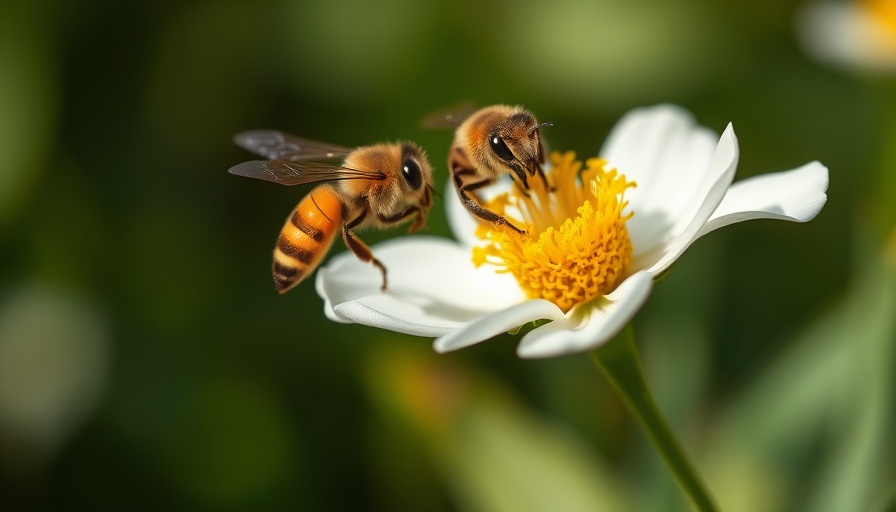
Transforming Your Space: The Science Behind Pollinator Gardens
The recent study from botanists at the University of Copenhagen and the National Botanic Garden of Wales has unveiled an exciting opportunity for urban dwellers to beautify their surroundings while supporting essential pollinators. As bees and hoverflies continue to face declines due to various environmental pressures, creating a flourishing garden or lawn can significantly influence their well-being and our own quality of life. By selecting from the study's top bee-magnet blooms, homeowners and municipalities can craft sustainable floral displays that are not only attractive but also vital for ecosystems.
Understanding the Importance of Bees and Hoverflies
Bees and hoverflies play pivotal roles in pollination, which is crucial for the reproduction of many plants and the production of fruits and vegetables. The decline of these insects has profound implications for biodiversity and food security. Implementing the study’s findings through flower strips and seed mixtures allows us to facilitate their recovery. Additionally, this initiative aligns seamlessly with the rising awareness of sustainable living and environmental conservation, particularly in urban areas like Dallas.
Top Recommendations for a Pollinator Paradise
The botanists identified ten flowers that stand out for their ability to attract bees and hoverflies while also pleasing human eyes:
- Yarrow (Achillea millefolium)
- Corn chamomile (Anthemis arvensis)
- Cornflower (Centaurea cyanus)
- Purple viper's bugloss (Echium plantagineum)
- Corn marigold (Glebionis segetum)
- Common poppy (Papaver rhoeas)
- Field mustard (Sinapis arvensis)
- Scentless chamomile (Tripleurospermum inodorum)
- Garden cosmos (Cosmos bipinnatus)
- Common phacelia (Phacelia tanacetifolia)
These blooms have been scientifically tested to ensure that they effectively draw in these crucial pollinators, assisting in biodiversity enhancement.
Creating Your own Urban Oasis
For individuals living in urban areas like Dallas, transforming a lawn or balcony into a flowering haven is increasingly possible, unobtrusive, and rewarding. With the city emerging as a vibrant hub, choosing to support local pollinators simultaneously encourages a healthier ecosystem and a visually dynamic environment. As you plan your garden, consider how aesthetically pleasing designs can also accommodate practical needs—using these species can create an impactful statement on environmental responsibility.
Future Trends: Gardening for Sustainability
With the continued emphasis on sustainability, we can expect to see more segments of urban life coalescing around bee-friendly practices. Homeowners are becoming influencers within their communities, promoting the benefits of tailored landscaping that highlights native and non-native flowering plants. Moreover, municipalities can take active roles in urban planning, creating more green spaces that facilitate better ecological health. The future may see cities adopting bee-friendly policies that promote biodiversity and educate residents about their ecological impact.
Practical Insights for Flower Selection
As you select seeds for your garden, it’s essential to incorporate both native and non-native species, as the study demonstrated that mixed flower types establish more robust ecosystems. Consider starting with the recommended species, planting them in strategic locations where they can receive adequate sunlight and water. Furthermore, organizing community gardening events can amplify these efforts, fostering neighborhood ties while contributing to the health of the local ecosystem.
Empowering Change: The Role of Individuals
“If everyone does a little, we can help” succinctly captures the essence of what individual efforts towards creating pollinator-friendly spaces can achieve. Every small change in our local landscapes contributes to a larger goal of environmental sustainability. By choosing to plant bee-friendly flowers, city residents are empowered to make a meaningful impact—not just for themselves but for generations to come.
Engage and Transform Your Environment
In Dallas and beyond, engaging with our environment through gardening fosters a deeper connection to nature and nurtures the creatures that pollinate the plants we depend on. With the newfound knowledge from this study, residents can become part of the solution, transforming their surroundings into flourishing havens for bees and hoverflies.
As the evidence mounts regarding the benefits of sustainable gardening practices, now is the time to take action. Consider starting a pollinator garden today and join the movement to create a greener, more vibrant community.
 Add Element
Add Element  Add Row
Add Row 



Write A Comment